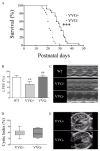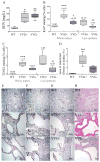Cardiac dysfunction in Pkd1-deficient mice with phenotype rescue by galectin-3 knockout
- PMID: 27475230
- PMCID: PMC4983501
- DOI: 10.1016/j.kint.2016.04.028
Cardiac dysfunction in Pkd1-deficient mice with phenotype rescue by galectin-3 knockout
Erratum in
-
Corrigendum to Balbo BE, Amaral AG, Fonseca JM, et al. Cardiac dysfunction in Pkd1-deficient mice with phenotype rescue by galectin-3 knockout. Kidney Int. 2016;90:580-597.Kidney Int. 2022 Mar;101(3):652. doi: 10.1016/j.kint.2022.01.002. Kidney Int. 2022. PMID: 35190044 Free PMC article. No abstract available.
Abstract
Alterations in myocardial wall texture stand out among ADPKD cardiovascular manifestations in hypertensive and normotensive patients. To elucidate their pathogenesis, we analyzed the cardiac phenotype in Pkd1(cond/cond)Nestin(cre) (CYG+) cystic mice exposed to increased blood pressure, at 5 to 6 and 20 to 24 weeks of age, and Pkd1(+/-) (HTG+) noncystic mice at 5-6 and 10-13 weeks. Echocardiographic analyses revealed decreased myocardial deformation and systolic function in CYG+ and HTG+ mice, as well as diastolic dysfunction in older CYG+ mice, compared to their Pkd1(cond/cond) and Pkd1(+/+) controls. Hearts from CYG+ and HTG+ mice presented reduced polycystin-1 expression, increased apoptosis, and mild fibrosis. Since galectin-3 has been associated with heart dysfunction, we studied it as a potential modifier of the ADPKD cardiac phenotype. Double-mutant Pkd1(cond/cond):Nestin(cre);Lgals3(-/-) (CYG-) and Pkd1(+/-);Lgals3(-/-) (HTG-) mice displayed improved cardiac deformability and systolic parameters compared to single-mutants, not differing from the controls. CYG- and HTG- showed decreased apoptosis and fibrosis. Analysis of a severe cystic model (Pkd1(V/V); VVG+) showed that Pkd1(V/V);Lgals3(-/-) (VVG-) mice have longer survival, decreased cardiac apoptosis and improved heart function compared to VVG+. CYG- and VVG- animals showed no difference in renal cystic burden compared to CYG+ and VVG+ mice. Thus, myocardial dysfunction occurs in different Pkd1-deficient models and suppression of galectin-3 expression rescues this phenotype.
Keywords: ADPKD; Pkd1-deficiency; apoptosis; cardiac dysfunction; cardiomyopathy; galectin-3.
Copyright © 2016 International Society of Nephrology. All rights reserved.
Figures











Similar articles
-
Smoking accelerates renal cystic disease and worsens cardiac phenotype in Pkd1-deficient mice.Sci Rep. 2021 Jul 14;11(1):14443. doi: 10.1038/s41598-021-93633-7. Sci Rep. 2021. PMID: 34262092 Free PMC article.
-
Renal cyst growth is the main determinant for hypertension and concentrating deficit in Pkd1-deficient mice.Kidney Int. 2014 May;85(5):1137-50. doi: 10.1038/ki.2013.501. Epub 2014 Jan 15. Kidney Int. 2014. PMID: 24429399 Free PMC article.
-
Disruption of polycystin-1 cleavage leads to cardiac metabolic rewiring in mice.Biochim Biophys Acta Mol Basis Dis. 2022 Jun 1;1868(6):166371. doi: 10.1016/j.bbadis.2022.166371. Epub 2022 Feb 24. Biochim Biophys Acta Mol Basis Dis. 2022. PMID: 35218894
-
Current advances in molecular genetics of autosomal-dominant polycystic kidney disease.Curr Opin Nephrol Hypertens. 2001 Jan;10(1):23-31. doi: 10.1097/00041552-200101000-00005. Curr Opin Nephrol Hypertens. 2001. PMID: 11195048 Review.
-
Translational research in ADPKD: lessons from animal models.Nat Rev Nephrol. 2014 Oct;10(10):587-601. doi: 10.1038/nrneph.2014.137. Epub 2014 Aug 19. Nat Rev Nephrol. 2014. PMID: 25137562 Review.
Cited by
-
c-Myc is a regulator of the PKD1 gene and PC1-induced pathogenesis.Hum Mol Genet. 2019 Mar 1;28(5):751-763. doi: 10.1093/hmg/ddy379. Hum Mol Genet. 2019. PMID: 30388220 Free PMC article.
-
Identification of housekeeping genes for microRNA expression analysis in kidney tissues of Pkd1 deficient mouse models.Sci Rep. 2020 Jan 14;10(1):231. doi: 10.1038/s41598-019-57112-4. Sci Rep. 2020. PMID: 31937827 Free PMC article.
-
Cardiac function assessed by myocardial deformation in adult polycystic kidney disease patients.BMC Nephrol. 2019 Aug 16;20(1):324. doi: 10.1186/s12882-019-1500-1. BMC Nephrol. 2019. PMID: 31419965 Free PMC article.
-
Hypertrophic and fibrotic human PKD hearts are associated with macrophage infiltration and abnormal TGF-β1 signaling.Cell Tissue Res. 2023 Jan;391(1):189-203. doi: 10.1007/s00441-022-03704-y. Epub 2022 Nov 15. Cell Tissue Res. 2023. PMID: 36376769 Free PMC article.
-
Editorial: Galectins and hormones in health and disease.Front Endocrinol (Lausanne). 2025 Feb 5;16:1545421. doi: 10.3389/fendo.2025.1545421. eCollection 2025. Front Endocrinol (Lausanne). 2025. PMID: 39974822 Free PMC article. No abstract available.
References
-
- Perrone RD, Ruthazer R, Terrin NC. Survival after end-stage renal disease in autosomal dominant polycystic kidney disease: Contribution of extrarenal complications to mortality. Am J Kidney Dis. 2001;38(4):777–84. - PubMed
-
- Rahbari-Oskoui F, Williams O, Chapman A. Mechanisms and management of hypertension in autosomal dominant polycystic kidney disease. Nephrol Dial Transplant. 2014;29(12):2194–201. - PubMed
-
- Chapman AB, Johnson AM, Rainguet S, et al. Left ventricular hypertrophy in autosomal dominant polycystic kidney disease. J Am Soc Nephrol. 1997;8(8):1292–7. - PubMed
-
- Bardají A, Vea AM, Gutierrez C, et al. Left ventricular mass and diastolic function in normotensive young adults with autosomal dominant polycystic kidney disease. Am J Kidney Dis. 1998;32(6):970–5. - PubMed
Publication types
MeSH terms
Substances
Grants and funding
LinkOut - more resources
Full Text Sources
Other Literature Sources
Molecular Biology Databases

